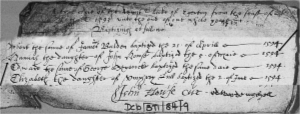Hannah Fuller's Ancestors |
Click on a name for info, click on an arrow to follow that branch, click Home to go to the main page, or click for an Alphabetic List of all Names. |
|
Note: Before 1752 the year began on March 25th. Dates between January 1st and March 24th were at the end of the year, not the beginning. |
| ~< Back to Chart >~ |
Samuel Fuller was born, probably in England about 1612, the son of Edward Fuller and his unnamed wife. As a child, he lived for a short time in Leiden, Holland with his parents and other English separatists (Protestant Christians who separated from the Church of England). Samuel sailed with his mother and father on the Mayflower in 1620 to New England. They were among the founders of Plymouth Colony, the first permanent European settlers in America. His parents both died during the first winter there. Samuel was then raised by his uncle, Dr. Samuel Fuller, who was the Pilgrim's doctor and the first physician in the new country.
Edward Winslow, Mourt's Relation: “our harvest being gotten in, our governour sent foure men on fowling, that so we might after a speciall manner rejoyce together, after we had gathered the fruits of our labours ; they foure in one day killed as much fowle, as with a little helpe beside, served the Company almost a weeke, at which time amongst other Recreations, we exercised our Armes, many of the Indians coming amongst us, and amongst the rest their greatest king Massasoyt, with some ninetie men, whom for three dayes we entertained and feasted, and they went out and killed five Deere, which they brought to the Plantation and bestowed on our Governour, and upon the Captaine and others. And although it be not always so plentifull, as it was at this time with us, yet by the goodness of God, we are so farre from want, that we often wish you partakers of our plentie.”
Shortly after the first Thanksgiving, the ship Fortune arrived with a new group of settlers. One of them, William Hilton, wrote the following letter: “Loving Cousin, At our arrival in New Plymouth, in New England, we found all our friends and planters in good health, though they were left sick and weak, with very small means; the Indians round about us peaceable and friendly; the country very pleasant and temperate, yielding naturally, of itself, great store of fruits, as vines of divers sorts in great abundance. There is likewise walnuts, chestnuts, small nuts and plums, with much variety of flowers, roots and herbs, no less pleasant than wholesome and profitable. No place hath more gooseberrries and strawberries, nor better. Timber of all sorts you have in England doth cover the land, that affords beasts of divers sorts, and great flocks of turkey, quails, pigeons and partridges; many great lakes abounding with fish, fowl, beavers, and otters. The sea affords us great plenty of all excellent sorts of sea-fish, as the rivers and isles doth variety of wild fowl of most useful sorts. Mines we find, to our thinking; but neither the goodness nor quality we know. Better grain cannot be than the Indian corn, if we will plant it upon as good ground as a man need desire. We are all freeholders; the rent-day doth not trouble us; and all those good blessings we have, of which and what we list in their seasons for taking. Our company are, for most part, very religious, honest people; the word of God sincerely taught us every Sabbath; so that I know not any thing a contented mind can here want. I desire your friendly care to send my wife and children to me, where I wish all the friends I have in England; and so I rest. Your loving kinsman, William Hilton”
After 15 years in America, on April 8, 1635, Samuel married Jane Lothrop. Samuel was 23 and Jane was 20 years old. It is said that the ceremony took place at Mr. Cudworth's and was performed by Captain Miles Standish, but this seems strange, since Jane’s father was a minister in the nearby town of Scituate but in the Plymouth Colony, marriages were considered a civil ceremony. Records show that Jane Lathrope, daughter of John Lathrope married Samuel Fuller on this date in Hebor, Tolland County, Connecticut. On November 7, 1636, Samuel joined the church of Jane’s father, Reverend John Lathrop, after providing a letter of dismissal from the church at Plymouth. That same year Samuel built for himself the fifteenth house in Scituate, on Greenfield street, on the first lot abutting on Kent Street, “a small plaine pallizadse House;” the walls were made of poles filled between with stones and clay, the roof thatched, the chimney to the mantel of rough stones and above of cob-work, the windows of oiled paper, and the floors of hand sawed planks. The kind of house has been described as meane, but all the houses in the village were alike. He also owned twenty acres in the east part of Bell House Neck. Samuel was a constable of Scituate in 1641, and his name appears a few times as juryman, or on committees to settle difficulties with the Indians.
The town of Barnstable bought, from the Secunke Indians, land called Scorton or Sandy Neck. They set off the arable land, reserved the rest for common land, and afterward divided it. The Fullers lived on this land. Samuel also bought a meadow from his brother Matthew, which had previously been owned by Major John Freeman, and also meadowland from Samuel House. Samuel (Fuller) also bought other lands, and lived in the northwest angle of Barnstable in a secluded spot, where travelers seldom passed. He was seldom in public life. Unlike his brother, he was retired and very pious. Matthew was a Puritan, but ambitious and energetic. Samuel was the only one of the passengers of the Mayflower who settled permanently at Barnstable, and in 1679, he was one of twelve survivors of that famous voyage. His will was dated October 29, 1683, and Samuel Fuller died on October 31, 1683 at Barnstable. (Click here to open a neatly written copy of his will in a new window/tab. This image is from the Wills, Inventories, etc, 1637 to 1685, County of Barnstable Film # 007705397 collection, images 147 - 149, on pages 194-7, found on FamilySearch.org.) Samuel Fuller was buried, if not on his own estate, then in the ancient burial place at Lothrop's Hill in Barnstable, near the site of the first meeting house. No gravestone now exists. |
| ~< Back to Chart >~ |
Jane married Samuel Fuller on April 8, 1635, in Hebor, Tolland County, Connecticut. They had nine children, the first four born and baptized in Scituate – ancestor Hannah, born in 1636; Samuel, baptized February 11, 1637, who married his cousin Ann Fulle, daughter of Matthewr; Elizabeth, born about 1639/40; Sarah, August 1, 1641, who died young; the last five children were born and baptized in Barnstable – Mary, baptized June 16, 1644; Thomas, born May 18, 1651, who married Elizabeth Lothrop, Jane’s niece; another Sarah, born December 10, 1654; John born January 11, 1655; and an unnamed infant (some say named Barnabas), born February 8, 1658, and died fifteen days later. It is believed that Jane Lothrop Fuller died in 1658, perhaps from complications in childbirth, in Barnstable, Massachusetts, at the age of 53. A death record for her has not been found. |
| ~< Back to Chart >~ |
Edward Fuller was baptized on September 4, 1575, in Redenhall, Norfolk, England, during the Reign of Queen Elizabeth I. He was the second of seven children born to Robert Fuller and Sarah Frances Dunkhorne. In 1602, Edward was married, but the name of his wife is unknown. There are sources that say her name was Ann, born between 1577 and 1581, but this is undocumented. They had two children - Mathew born in October of 1605 and ancestor Samuel. Where these boys were born is unknown, as they are not listed in the Redenhall Parish Register.
The original text of Mayflower Compact: “In ye name of God, Amen. We whose names are underwritten, the loyall subjects of our dread soveraigne Lord, King James, by the grace of good, of Great Britaine, Franc, and Ireland king, defender of the faith, etc. Haveing undertaken, for ye glorie of God, and advancemente of ye Christian faith, and honour of our king and countrie, a voyage to plant ye first colonie in ye Northerne parts of Virgina, doe by these presents solemnle and mutualy in ye presence of God, and one of another, covenant & combine our selves togeather into a civill body politick, for ourbetter ordering & preservation & furtherance of ye ends of Signers of document: “John Carver, William Bradford, Edward Winslow, William Brewster, Isaac Allerton, Miles Standish, John Alden, Edward Tilly, John Tilly, Francis Cook, Thomas Rogers, Thomas Tinker, John Rigdale, Edward Fuller, Digery Priest, Thomas Williams, Gilbert Winslow, Edmund Margeson, Peter Brown, Richard Bitteridge, George Soule, Samuel Fuller, Christopher Martin, James Chilton, John Craxton, John Billington, Moses Fletcher, John Goodman, John Turner, Francis Eaton, John Allerton, Thomas English, Edward Doten, Edward Leister, Richard Clark, William Mullins, William White, Richard Warren, John Howland, Stephen Hopkins.” During the winter the passengers remained on board the Mayflower, suffering an outbreak of a contagious disease described as a mixture of scurvy, pneumonia and tuberculosis. When it ended, there were only 53 passengers, just more than half, still alive. Likewise, half of the crew died as well. In spring, they built huts ashore, and on March 21, 1621, the surviving passengers left the Mayflower. Edward died between January 11 and April 10, 1621 and his wife died early in 1621, after January 11th. This was during what William Bradford, governor and historian called “first sickness” and “the Starving Time” in his historical record, Plimouth Planation. Bradford also stated that “Edward ffuller, and his wife dyed soon after they came ashore; but their sonne Samuel is living, and maried, and hath 4 children or more.” This would seem to indicate that they died shortly after March 21st. The raising of their son, Samuel was taken over by Edward’s brother Samuel.
“There are now (1954) four memorials to the Pilgrims on Cole's Hill... The sarcophagus (pictured right), within which have been deposited the bones of the Pilgrims which have been found at various times in or near its location, erected by the General Society of Mayflower Descendants in 1920." The inscription on the Sarcophagus reads: |
| ~< Back to Chart >~ |
John entered Christ Church College, Oxford at sixteen years old “a pleb of Christ Church 15 Oct. 1602.” He then went to Cambridge, for a degree of Bachelor of Arts from Queen's College in 1606, and to that of Master of Arts in 1609.On January 10, 1609/10, he was appointed curate at the St Mary the Virgin and the Holy Rood in Little Chart, which is 4 miles northwest of Ashford in Kent County The Reverend Elijah Baldwin Huntington in his book, A Genealogical Memoir of the Lo-Lathrop Family, writes: “Although the bulk of American descendants of John spell their name Lathrop or Lothrop, documents in John's hand consistently give his name as Lothropp, the spelling used in this biography. Sources include Egerton, Kent parish registers and bishop's transcripts 1611-23 recorded in John's hand; Letters written to Gov. Thomas Prence 18 February 1638 & 28 September 1638 signed John Lothropp; Scituate & Barnstable church records 1637-53, including entries such as ‘My sonn Thomas Lothropp joyned May 14, 1637.’” On October 10, 1610, a marriage license was issued in Canterbury, Kent County, the center of the Church of England, to “Lothropp, John, M.A., curate of Egerton, and Hannah Howse of Eastwell, v. At Eastwell” (the v. stands for virgin). This license is listed in Joseph Meadows Cowper’s Canterbury Marriage Licenses, first series, 1568-1618. They probably married shortly after in Eastwell in Kent County. John was nearly 26 and Hannah was about 16 and a half years old. See Hannah’s bio below for information on their children. John was ordained in the Church of England and, about 1611, the Dean and Chapter of St. Paul appointed him curate of a local parish in Egerton, Kent, 48 miles southeast of London. Here In 1625, after 22 years of relative religious tolerance by King James, Charles I became King of England. Religious conflicts permeated Charles's reign, and many who disagreed with the Church of England were persecuted. On April 29, 1632, officers of the king arrested forty-two of Lothropp's Independents, including John and two of his children, at the house of Mr. Humphrey Barnet. Only eighteen escaped capture. They were prosecuted for failure to take the oath of loyalty to the established church. They were jailed in The Clink prison. All were released on bail by the spring of 1634 except John, who was deemed too dangerous to be set at liberty. He petitioned King Charles I for liberty to depart from the kingdom, but his petition was rejected. While John was in prison, his wife, Hannah fell sick, and he was permitted to visit her. Shortly after this she died between April and May of 1634 and John's children were placed in the care of some friends, who could scarcely support them. As a result, John's children were often forced to live on the streets and beg for food. Some friends sent the children to petition the Bishop of Lambeth for their father's freedom, who upon realizing their pathetic state, ordered that Reverend John be released from prison in May or June of 1634. Lothropp was told that he would be pardoned upon acceptance of terms to leave England permanently with his family along with as many of his congregation members as he could take who would not accept the authority of the Church of England. Lothropp accepted the terms of the offer and left for Plymouth, Massachusetts. With his group, he sailed on the ship Griffin and arrived in Boston on September 18, 1634. Governor Winthrop's Journal, quotes John Lothropp, a freeman, rejoicing in finding a “church without a bishop,” . . . “and a state without a king.” “The Griffin and another ship now arriving with about 200 passengers. Mr. Lothropp and Mr. Sims, two godly ministers coming in the same ship." On the next page it says - “Mr. Lothrop had been a pastor of a private congregation in London, and for the same, kept long in prison, upon refusal of the oath, ex-officio, being in Boston upon a sacrament day, after the sermon, desired leave of the congregation to be present at the administration, but said that he durst not desire to partake in it, because he was not then in order, being dismissed from his former congregation, and he thought it not fit to be suddenly admitted into any other for example sake, and because of the deceitfulness of man's heart.” On reaching Boston with that portion of his London flock that had accompanied him, he found already the preparations begun to welcome him to a new home in Scituate. Within days, he and his group relocated to Scituate where they “joyned in covenaunt together” along with nine others who preceded them to form the “church of Christ collected att Scituate.”
The Congregation at Scituate was not a success. Dissent on the issue of baptism as well as other unspecified grievances and the lack of good grazing land and fodder for their cattle caused the church in Scituate to split in 1638. Lothropp petitioned Governor Thomas Prence in Plymouth for a “place for the transplanting of us, to the end that God might have more glory and wee more comfort.” Mr. Lothropp and a large company arrived in Barnstable, October 11, 1639, bringing with them the crops which they had raised in Scituate. There, within three years, they had built homes for all the families and then Lothropp began construction on a larger sturdier meeting house by Coggin's (or Cooper's) Pond, which was completed in 1644 (see picture right). This building, now part of the Sturgis Library in Barnstable, Massachusetts is one of John Lothropp's original homes and meeting houses, and is now also the oldest building housing a public library in America. John and Anna had five more children in Barnstable – Abigail on November 2, 1639, married James Clark; Bathsheba on February 16, 1640/41, married twice; Elizabeth in about 1643, married John Williams; a second son named; John on February 9, 1643/44, married twice and was known as Captain; and an unnamed son who was born and died “immediately after it was born” on January 25, 1649/50. Reverend John Lothropp wrote his will on August 10, 1653, but did not sign it. He died in Barnstable on November 8, 1653. The will was printed in Kemble Stout’s book about the Stout Ancestors and Descendants and it reads as follows: “The last Will and Testament of Mr. John Lothropp ye pe.stour of the Church of Christ att Barnstabie, August 10th 1653. First. I will and bequeath unto my wife the house wherein I now dwell with the furniture thereof, and the ground belonging thereunto with the marsh land that lyeth on the East besides Randevow Creek, and alsoe my ground in the Common field. To my son Thomas my eldest sonne I will and bequeath the house I first lived in in Barnstable with the ground belonging thereunto and the marsh joyning to the lower end thereof which butts and bounds upon the Creeke northward, with this condition, that hee my said sonne Thomas is to give to my sonne John in England and to my sonne Benjamin heer in the bay each of them a good Cow of five pounds My daughter Jane and my daughter Barbarah have had their portions alreaddy. To the rest of my children both mine and my wives my will is that every [one] of them shall have a Cow. My will is alsoe that my great lott and my great marsh shall be sold to some particular person and that which comes by the sale thereof to be equally divided amongst them that have the least portions.
On December 8, 1653, an inventory of his estate was taken, totaling over £72, which included £5 for his books. On March 7, 1653/4, the will was probated and administration was granted on his estate to “Mrs. Laythorpe.” Both the will and the inventory are recorded in volume 1 of the Plymouth Colony Wills and Inventories. John was buried on November 10, 1653, in Lothrop Hill Cemetery in Barnstable. His second wife, Anna died there on February 25, 1687/88. An author of history, Huntington, wrote “He was a man of humble and broken heart spirit, lively in dispensation of the Word of God, studious of peace, furnished with godly contentment, willing to spend and be spent for the cause of the church of Christ.” |
| ~<^>~ |
On April 22, 1632, her husband John was imprisoned for his outspoken religious beliefs (See John above for details). While he was still in prison, Hannah fell sick, and he was permitted to visit her. Shortly after this Hannah Howse Lothrop died in London on February 16, 1634, at the age of 39. |
| ~< Back to Chart >~ |

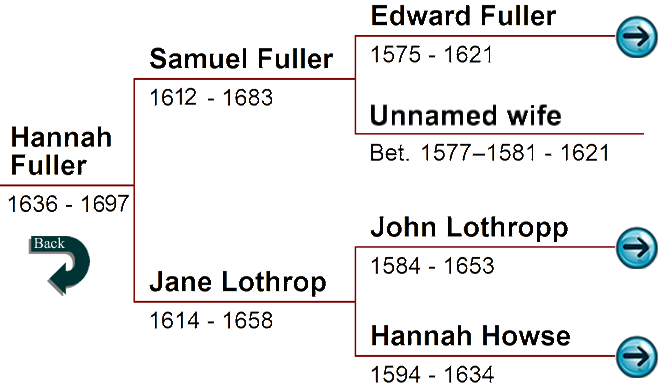
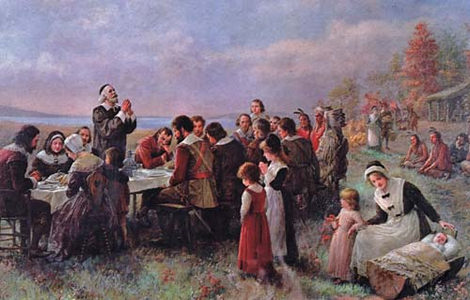 The first harvest was a good one and, as was tradition, they held a thanksgiving feast. There were 53 Pilgrims there and they were joined by a large group of Native Americans. This is commemorated in our modern Thanksgiving holiday every November. Here are two first-hand accounts of that first Thanksgiving celebration in the fall of 1621:
The first harvest was a good one and, as was tradition, they held a thanksgiving feast. There were 53 Pilgrims there and they were joined by a large group of Native Americans. This is commemorated in our modern Thanksgiving holiday every November. Here are two first-hand accounts of that first Thanksgiving celebration in the fall of 1621: William Bradford, Of Plimoth Plantation: “They begane now to gather in ye small harvest they had, and to fitte up their houses and dwellings against winter, being all well recovered in health & strenght, and had all things in good plenty; fFor as some were thus imployed in affairs abroad, others were excersised in fishing, aboute codd, & bass, & other fish, of which yey tooke good store, of which every family had their portion. All ye somer ther was no want. And now begane to come in store of foule, as winter approached, of which this place did abound when they came first (but afterward decreased by degrees). And besids water foule, ther was great store of wild Turkies, of which they tooke many, besids venison, &c. Besids, they had about a peck a meale a weeke to a person, or now since harvest, Indean corn to yt proportion. Which made many afterwards write so largly of their plenty hear to their freinds in England, which were not fained, but true reports.”
William Bradford, Of Plimoth Plantation: “They begane now to gather in ye small harvest they had, and to fitte up their houses and dwellings against winter, being all well recovered in health & strenght, and had all things in good plenty; fFor as some were thus imployed in affairs abroad, others were excersised in fishing, aboute codd, & bass, & other fish, of which yey tooke good store, of which every family had their portion. All ye somer ther was no want. And now begane to come in store of foule, as winter approached, of which this place did abound when they came first (but afterward decreased by degrees). And besids water foule, ther was great store of wild Turkies, of which they tooke many, besids venison, &c. Besids, they had about a peck a meale a weeke to a person, or now since harvest, Indean corn to yt proportion. Which made many afterwards write so largly of their plenty hear to their freinds in England, which were not fained, but true reports.”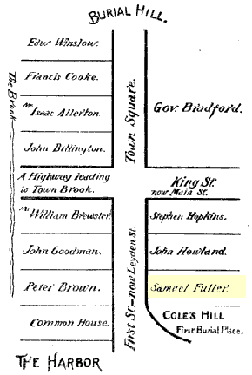 Samuel had three shares at the division of lands in 1623, receiving, it is thought, those of his father and mother, and one for himself. The land assigned to him was on the south side of the town brook, to the woodward, and included what is now Watson's Hill. His neighbors were John Howland, Stephen Hopkins, Edward Winslow, Gilbert Winslow, and the Indian Hobomok. Between 1630 and 1633, his uncle Samuel died and left him cattle, swine, and personal effects. He was the executor of his uncle's will and became a freeman of the colony in 1634.
Samuel had three shares at the division of lands in 1623, receiving, it is thought, those of his father and mother, and one for himself. The land assigned to him was on the south side of the town brook, to the woodward, and included what is now Watson's Hill. His neighbors were John Howland, Stephen Hopkins, Edward Winslow, Gilbert Winslow, and the Indian Hobomok. Between 1630 and 1633, his uncle Samuel died and left him cattle, swine, and personal effects. He was the executor of his uncle's will and became a freeman of the colony in 1634.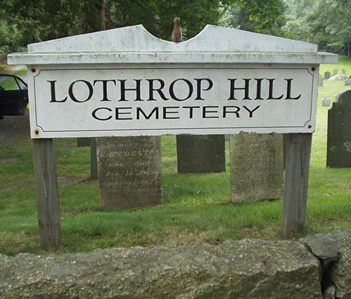 In 1639, the Reverend Lathrop and many of the members of his church moved and founded the town of Barnstable, probably at the time the most easterly settlement on Cape Cod. Samuel and his family followed him there as early as 1641, certainly before January 1, 1644. Captain Matthew Fuller, Samuel's older brother, appears to have moved from Plymouth at about the same time.
In 1639, the Reverend Lathrop and many of the members of his church moved and founded the town of Barnstable, probably at the time the most easterly settlement on Cape Cod. Samuel and his family followed him there as early as 1641, certainly before January 1, 1644. Captain Matthew Fuller, Samuel's older brother, appears to have moved from Plymouth at about the same time.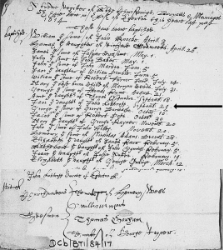
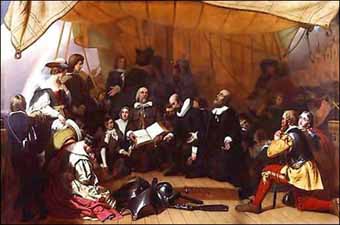 Edward’s father died on May 23, 1614. After receiving 20 pounds in his father's will in 1614, Edward sold all his possessions and moved to Leiden, Holland, where he joined the Separatist Church. A single Leiden judicial document mentions Edward Fuller, and proves that he, like his brother Samuel Fuller, were living in Leiden. This move may have been prompted by the persecution of Puritans under James, who became king of England in 1603 following the death of Elizabeth.
Edward’s father died on May 23, 1614. After receiving 20 pounds in his father's will in 1614, Edward sold all his possessions and moved to Leiden, Holland, where he joined the Separatist Church. A single Leiden judicial document mentions Edward Fuller, and proves that he, like his brother Samuel Fuller, were living in Leiden. This move may have been prompted by the persecution of Puritans under James, who became king of England in 1603 following the death of Elizabeth.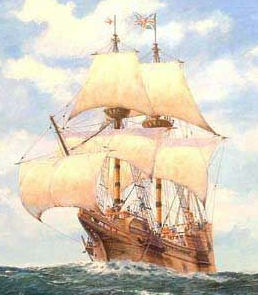 In 1620 Edward made the decision to take his wife and young son Samuel to America. Their son Mathew, about 15 years old, stayed behind in Holland, but followed them to America in a later expedition in 1640. Edward’s brother Samuel, who was a doctor and deacon, was also with them on this voyage. Two ships left Holland together, the Mayflower, a hired ship, and the smaller ship the Speedwell, owned by the Pilgrims. They both sailed to England and then set out from Southampton. Leaks in the Speedwell forced the ships to put into Dartmouth for repairs. The two ships proceeded to sea, but because of damage to the Speedwell, they were forced to return to Plymouth, where she was sold. Some of her passengers crowded aboard the Mayflower, while others stayed in England to await passage the next year. The Mayflower left England on September 16, 1620 and after a grueling 66-day journey marked by disease, which claimed two lives, the ship dropped anchor inside the hook tip of Cape Cod on November 11th. Edward was the 21st signer of the Mayflower Compact, the agreement drawn up in the cabin of the Mayflower shortly before the landing at Plymouth Rock.
In 1620 Edward made the decision to take his wife and young son Samuel to America. Their son Mathew, about 15 years old, stayed behind in Holland, but followed them to America in a later expedition in 1640. Edward’s brother Samuel, who was a doctor and deacon, was also with them on this voyage. Two ships left Holland together, the Mayflower, a hired ship, and the smaller ship the Speedwell, owned by the Pilgrims. They both sailed to England and then set out from Southampton. Leaks in the Speedwell forced the ships to put into Dartmouth for repairs. The two ships proceeded to sea, but because of damage to the Speedwell, they were forced to return to Plymouth, where she was sold. Some of her passengers crowded aboard the Mayflower, while others stayed in England to await passage the next year. The Mayflower left England on September 16, 1620 and after a grueling 66-day journey marked by disease, which claimed two lives, the ship dropped anchor inside the hook tip of Cape Cod on November 11th. Edward was the 21st signer of the Mayflower Compact, the agreement drawn up in the cabin of the Mayflower shortly before the landing at Plymouth Rock.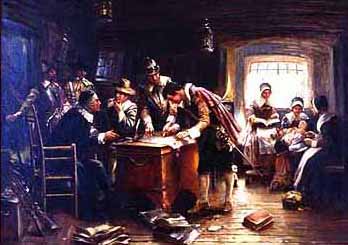 afresaid; and by vertue hearof to enacte lawes, ordinances,act constitutions,& offices from time to time, as shall be thought most meet & convenient for ye generall good of ye Colonie, unto which we promise all ldue submission and obedience. In witnes wherof we have hereunder subscribed our names at Cap-Codd ye 11th of November, in ye year of ye raigne of our soveraigne lord, King James, of England, France & Ireland ye eighteenth, and of Scotland, ye fiftie fourth. Ano: Dom. 1620.”
afresaid; and by vertue hearof to enacte lawes, ordinances,act constitutions,& offices from time to time, as shall be thought most meet & convenient for ye generall good of ye Colonie, unto which we promise all ldue submission and obedience. In witnes wherof we have hereunder subscribed our names at Cap-Codd ye 11th of November, in ye year of ye raigne of our soveraigne lord, King James, of England, France & Ireland ye eighteenth, and of Scotland, ye fiftie fourth. Ano: Dom. 1620.”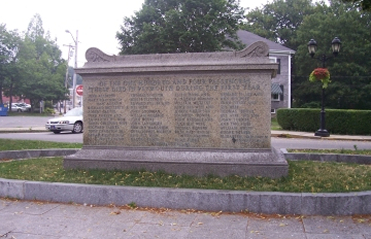 Edward Fuller and his wife are buried at Cole’s Hill Burial Ground, Plymouth, Plymouth County Massachusetts. The Pilgrim Hall Museum web site states “Cole's Hill, rising from the shore near the center of town and overlooking the Rock and the harbor, has occupied a prominent place in the affairs of the community. Here were buried the bodies of those who died during the first years of the settlement…”
Edward Fuller and his wife are buried at Cole’s Hill Burial Ground, Plymouth, Plymouth County Massachusetts. The Pilgrim Hall Museum web site states “Cole's Hill, rising from the shore near the center of town and overlooking the Rock and the harbor, has occupied a prominent place in the affairs of the community. Here were buried the bodies of those who died during the first years of the settlement…”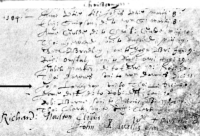
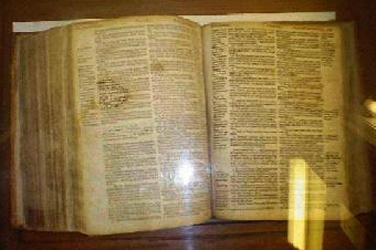 Mr. Lothropp labored faithfully as long as his judgement could approve the ritual and government of the Church. In about 1623, he renounced his orders and joined the cause of the Independents. Lothropp gained prominence in 1624, when he was called to replace Reverend Henry Jacob as the pastor of the First Independent Church in London, a congregation of sixty members, which met at Union Street, Southwark. Church historians sometimes call this church the Jacob-Lathrop-Jessey Church, named for its first three pastors, Henry Jacob, John Lothropp and Henry Jessey. They were forced to meet in private to avoid the scrutiny of Bishop of London William Laud, who later became Archbishop of Canterbury. (John's bible is pictured left.)
Mr. Lothropp labored faithfully as long as his judgement could approve the ritual and government of the Church. In about 1623, he renounced his orders and joined the cause of the Independents. Lothropp gained prominence in 1624, when he was called to replace Reverend Henry Jacob as the pastor of the First Independent Church in London, a congregation of sixty members, which met at Union Street, Southwark. Church historians sometimes call this church the Jacob-Lathrop-Jessey Church, named for its first three pastors, Henry Jacob, John Lothropp and Henry Jessey. They were forced to meet in private to avoid the scrutiny of Bishop of London William Laud, who later became Archbishop of Canterbury. (John's bible is pictured left.)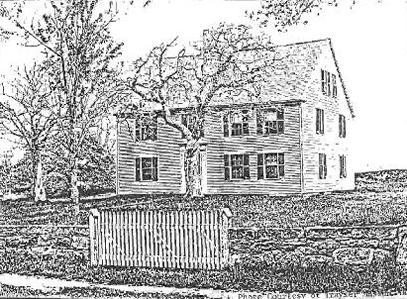 Some researchers say that there, on September 27, 1634, John married Anna, whose surname is unknown. What we do know is that they were married prior to June 14, 1635, as on that date, an entry in the Scituate Church records states, “My Wife and Brother Foxwell's wife joyned having their dismission from elsewhere.” (Her given name is documented in the Barnstable Church records on September 19, 1683, as “Widdow Anna Lothrop of Pastor Lothrop.”) John and Anna had two children while living in Scituate – Barnabas, baptized on June 6, 1636, married twice; and an unnamed daughter who was born and died on July 30, 1638. John was made a Freeman and took the oath on March 7, 1637.
Some researchers say that there, on September 27, 1634, John married Anna, whose surname is unknown. What we do know is that they were married prior to June 14, 1635, as on that date, an entry in the Scituate Church records states, “My Wife and Brother Foxwell's wife joyned having their dismission from elsewhere.” (Her given name is documented in the Barnstable Church records on September 19, 1683, as “Widdow Anna Lothrop of Pastor Lothrop.”) John and Anna had two children while living in Scituate – Barnabas, baptized on June 6, 1636, married twice; and an unnamed daughter who was born and died on July 30, 1638. John was made a Freeman and took the oath on March 7, 1637.
